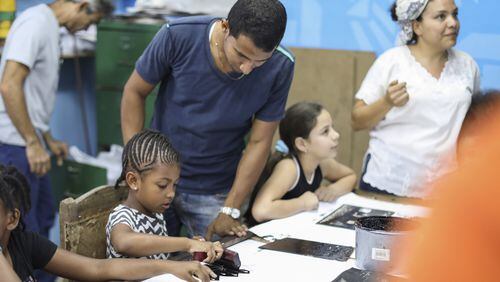Language immersion schools have found a following in recent years, putting into action research that demonstrates children can learn the intricacies of another tongue more rapidly than adults. That was an important consideration for Atlanta mom Malika Smith when it came time to enroll her son, Colin, in pre-school.
“I’ve always been interested in culture and language,” said Smith. “I believe it’s important for him to learn the world is accessible to him, and part of that is learning a second language. In this school, he can broaden his language horizons and global view of the world.”
Smith started her son in the Little Linguists pre-school program in Decatur that expanded its outreach with the Green School, a dual-language immersion school in East Point that accepts students in kindergarten through third grade. Students spend every-other day speaking and taking classes in Spanish, but as Smith knows, classroom lessons and workbook exercises can only take a student so far. So she organized a trip to Cuba for students to put their language skills into action.
“I wanted a way to give them an immersive experience to practice not only the language but also to the learn the culture,” she said. “Cuba was a great choice because it’s just beginning to open up to allow these educational discovery programs, and it’s still somewhat unexplored by many Americans. It’s also close, and when you’re traveling with elementary school kids, the geographic proximity was a plus.”
In early February, 34 Green School students ages 5 through 9, parents, a few grandparents and teachers spent six days exploring the island’s cultural and linguistic offerings.
“We had an educational agenda but didn’t pack it too tight because of the kids’ ages,” said Smith. “We stayed in old Havana, did tours in classic American cars, took salsa and Latin dance lessons and spent half day at a community arts center where our kids met other children and did projects with them.”
The trip also featured a tour of author Ernest Hemingway’s house, a day trip to a tobacco-growing World Heritage site and a visit to the U.S. embassy.
“That visit was special because it was the first time they did a briefing for children,” said Smith. “Typically, briefings are only done for adults, but this talk talked about what an embassy and ambassador is, what they do, what it’s like being in the foreign service and what politics in Cuba are like – but all in an appropriate way for elementary school kids.”
And there were opportunities for the students to work on their communication skills. “Most of them are in their first through third year of learning Spanish, so they understood more than they could speak,” said Smith. “But they did get to practice and hear the accent specific to Cuba.”
The Green School’s small size, with about 60 in the lower school and 15 in upper, affords it the flexibility to incorporate lessons such as immersion trips into the curriculum, said Director Raquel Paulino.
“Being a small, private, language immersion school, we can do that,” said Paulino. “In 2014, we went to Costa Rica, and last year we organized about nine field trips. But our goal is to do an annual trip as well, and right now my emails are all asking when the next one will be. Everyone’s very enthusiastic.”
One of those enthused participants was Paulino’s 9-year-old daughter, Tatu. “We could walk where we wanted to go; we didn’t have to use cars.” she said. “I liked the art center where we made drawings and left them to be displayed. And oh yeah, we ate a lot of rice and beans.”
Smith’s friends are still “shocked” when she tells them her 6-year-old went to Cuba. “They think back to their elementary school days and remember going to local plays or museums, which the kids do frequently, too. But the school is taking it a step further and extending their ‘playground’ to include areas outside of their local, and even national, realm.”
Information about the Green School: littlelinguistspreschool.com/programs/greenschool.cfm.






